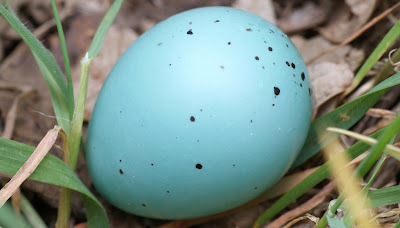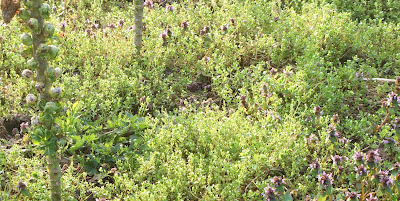These are a few photos of yesterday's lunchtime walk around Duck End NR - it's amazing what you can find in a short time!

This is the first time I've come across this Shieldbug -
Troilus luridus. I love the metallic colours and the way in which they blend together...and the antennae headlights are pretty impressive!

Beautiful or what!! Male Orange-tip Butterfly.

Soon after hearing a real clamour of various alarmed birds, I came across this Song Thrush egg at the base of a bramble. It was at the entrance of a small mammal run, so I wondered whether I'd disturbed a Stoat or Weasel, but a Magpie also flew off as I turned the corner - the more likely culprit, I feel!

The Adder's Tongue Fern is one of Duck End's special plants. You can see the two rows of reproductive spores on the spike, which gives the plant its name. The 'Green Oil of Charity' was the name of a poultice of this plant's leaves and rhizomes which was applied to wounds. A leaf tea of this plant was also given to people who were vomiting!

I should have posted this on Friday: April 23rd, St George's Day. This is the St George's Day mushroom - it was fruiting in Galler's Pasture.

Bigger bugs, like the Shieldbug above, can be very dramatic in appearance, but I find the smaller ones fascinating, too. Thanks to Bernard Nau & Sheila Brooke for helping me to identify this as
Anthocoris nemoralis.

Thanks to our new Weevil Recorder, Wilf Powell, for identifying this Weevil as
Rhynchites aequatus. It was swept from an apple tree by the entrance to the Reserve, and Wilf remarks that this species sometimes becomes a pest of cultivated apple trees.

Here's something I'm still working on which I thought would be straightforward - is this Ladybird a Cream-streaked Ladybird or a 10-spot Ladybird? The diagrams and photos I've come across look remarkably similar. The Cream-streaked Ladybird is more of a conifer specialist which would make it less likely, but I'm not a 100% convinced yet...I guess this is the best way of learning!
Update: Thanks to Helen from
The Ladybird Survey, who has confirmed that this is a 10-spot Ladybird (colour form:
decempunctata). Helen says that 10-spots are smaller and less domed than the Cream-streaked, but they are tricky to tell apart.
 This Frosted Green had settled down on the outside of the trap.
This Frosted Green had settled down on the outside of the trap. This is the May Highflyer, the larvae of which feed on Alder.
This is the May Highflyer, the larvae of which feed on Alder.  It's great when you can combine work with a walk in the countryside. Liz and I explored a few gravel pits this afternoon in a search for damselflies. At one spot we found large numbers of Large Red Damselflies....and a single Blue-tailed Damselfly! On the track to Rookery Pit we came across this young Bank Vole - it spent most of the time with its eyes closed, though they seemed to be ok when they were open.
It's great when you can combine work with a walk in the countryside. Liz and I explored a few gravel pits this afternoon in a search for damselflies. At one spot we found large numbers of Large Red Damselflies....and a single Blue-tailed Damselfly! On the track to Rookery Pit we came across this young Bank Vole - it spent most of the time with its eyes closed, though they seemed to be ok when they were open. When this moth flies past your line of vision it's like an avant garde fashion icon, flashing its garish colours! It's a Cinnabar Moth and is the adult version of the caterpillars mentioned in a previous post here. It's pumped full of poisonous pyrrolidizine alkaloids imbibed from the Ragwort plants it feeds on. Those colours are like a big neon sign to any potential predators: "I don't taste good!!"
When this moth flies past your line of vision it's like an avant garde fashion icon, flashing its garish colours! It's a Cinnabar Moth and is the adult version of the caterpillars mentioned in a previous post here. It's pumped full of poisonous pyrrolidizine alkaloids imbibed from the Ragwort plants it feeds on. Those colours are like a big neon sign to any potential predators: "I don't taste good!!"














































